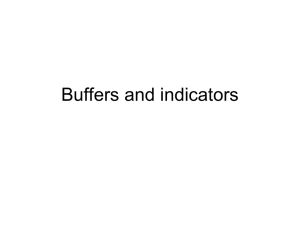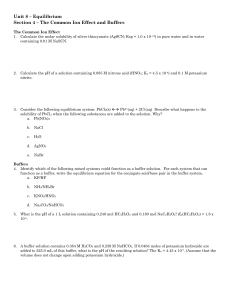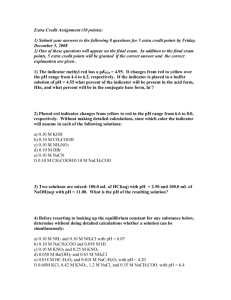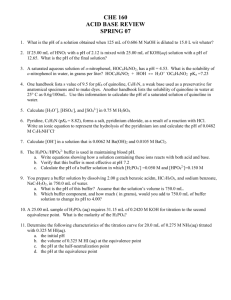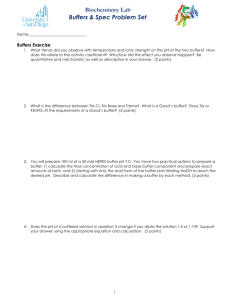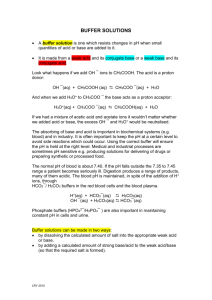UNIT IV PPT #7 - Buffers
advertisement
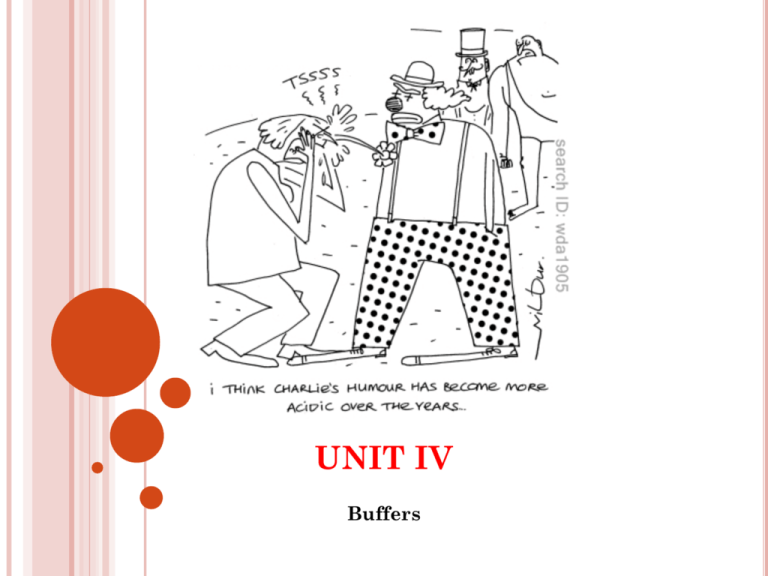
UNIT IV Buffers WHAT IS A BUFFER? A buffer solution is a solution which resists changes in pH when a small amount of acid or base is added. Or we could say it minimizes the change in pH when acid or base is added. WHAT IS A BUFFER? Say you had some 1.0 M acetic acid (CH3COOH) solution. This equilibrium becomes established: CH3COOH + H2O H3O+ + CH3COO [I] 1.0 0 0 [C] -x +x +x [E] Since CH3COOH is a WEAK acid, the [H3O+] and [CH3COO-] are quite low at equilibrium. WHAT IS A BUFFER? Now, lets add some sodium acetate (NaCH3COO) to the equilibrium mixture so that [ CH3COO-] is 1.0 M. When we do this the [ CH3COO-] obviously goes up. However, by LeChatelier’s Principle, the equilibrium will shift to the LEFT, causing [H3O+] to decrease and [CH3COOH] to increase. CH3COOH + H 2O H3O+ + CH3COO- WHAT IS A BUFFER? So what we have produced is a solution that has a fairly high concentration ( ≈ 1M ) of a WEAK ACID (CH3COOH) and a WEAK BASE (CH3COO- ) in the same solution. This is how a buffer solution is prepared. Since the acid and the base are both WEAK, they don’t neutralize each other like a mixture of a SA and SB would. They co-exist in this equilibrium unless disturbed! TYPES OF BUFFER SOLUTIONS There are two kinds of Buffer Solutions: I. ACIDIC BUFFER: A Weak Acid and the Salt of Its Conjugate Base (useful in the acidic range) eg. 1.0 M CH3COOH & 1.0 M NaCH3COO II. BASIC BUFFER: A Weak Base and the Salt of Its Conjugate Acid (useful in the basic range) eg. 1.0 M NH3 & 1.0 M NH4Cl TYPES OF BUFFER SOLUTIONS http://www.mhhe.com/physsci/chemistry/essentialchemistry/flash/buffer12.swf TYPES OF BUFFER SOLUTIONS Some examples: Acidic Buffers 1.0 M HNO2 & 1.0 M KNO2 Basic Buffers 1.0 M NH3 & 1.0 M NH4Cl 0.1 M NaH2PO4 & 0.1 M Na2HPO4 0.2 M H2C2O4 & 0.20 M NaHC2O4 1.0 M NH3 & 1.0 M NH4NO3 1.0 M N2H4 & 1.0 M N2H5Br NOTE: Buffers CANNOT be prepared using any STRONG ACIDS or STRONG BASES!!! Strong acids and bases are too reactive, and will not remain in an equilibrium mixture. They will react! HOW A BUFFER WORKS Consider the buffer solution made up of 1M CH3COOH and 1M NaCH3COO. The equation representing the equilibrium present in this buffer solution is (just the same as the ionization of the weak acid, CH3COOH): CH3COOH 1M + H 2O H 3O + low + CH3COO1M Now, we add a small amount of HCl to this solution… HOW A BUFFER WORKS The HCl produces H3O+, so the [H3O+] will immediately increase (and the pH will go down). However, since this is an equilibrium and there is plenty of CH3COO- available, the equilibrium will SHIFT to the LEFT and [H3O+] will go back down again (but not quite to its original value). [H3O+] Time Draw a graph of pH vs. Time when a small amount of HCl is added to the buffer above. HOW A BUFFER WORKS This time we add a small amount of base NaOH: The NaOH produces OH- which neutralizes H3O+ so the [H3O+] will immediately decrease (and the pH will go up). CH3COOH + H 2O H 3O + + CH3COO However, since this is an equilibrium and there is plenty of CH3COOH available, the equilibrium will SHIFT to the RIGHT and [H3O+] will go back up again (but not quite to its original value). [H3O+] Time Draw a graph of pH vs. Time when a small amount of NaOH is added to the buffer above. CHECK YOUR UNDERSTANDING Ex. A buffer solution is prepared using 1M NH3 and 1M NH4Cl. a) Write the equilibrium equation describing this buffer. b) When a small amount of HCl (SA) is added, the [OH-] quickly _____creases (the pH goes ________ ). c) As a result, the equilibrium shifts to the _____________, and the [OH-] gradually _____creases (the pH goes back ________). d) So, as a result of adding HCl, there was a small net _____crease in the [OH-] (a small net ___ crease in pH ). e) Draw a graph of [OH-] vs. Time to illustrate what happened in b d. Label each part. f) Draw a graph of pH vs. Time to illustrate what happened in b d. CHECK YOUR UNDERSTANDING Ex. A buffer solution is prepared using 1M NH3 and 1M NH4Cl. a) Write the equilibrium equation describing this buffer. b) When a small amount of NaOH (SB) is added, the [OH-] quickly _____creases (the pH goes ________ ). c) As a result, the equilibrium shifts to the _____________, and the [OH-] gradually _____creases (the pH goes back ________). d) So, as a result of adding NaOH, there was a small net _____crease in the [OH-] (a small net ___ crease in pH ). e) Draw a graph of [OH-] vs. Time to illustrate what happened in b d. Label each part. f) Draw a graph of pH vs. Time to illustrate what happened in b d. LIMITATIONS OF BUFFERS Say we have a buffer solution prepared using 1M CH3COOH and 1M NaCH3COO. The equilibrium describing this buffer solution is: CH3COOH 1M + H 2O H3O+ low + CH3COO1M Let’s say we add 1.5 moles of HCl to 1 Litre of this solution. The [H3O+] will immediately go up to 1.5 M. This is more than the 1 M CH3COO- can handle (react with). There will still be an excess of H3O+ large enough to bring the pH down significantly. LIMITATIONS OF BUFFERS In the above case we have overcome the limitations of our buffer and it cannot hold the pH relatively constant any more. Buffers only maintain a relatively constant pH when SMALL amounts of acid or base are added to them! LIMITATIONS OF BUFFERS Looking at the “buffer region” of the titration curve for a WA-SB titration illustrates how the buffer “loses control” of the pH when the [base] overcomes the buffer: USES OF BUFFERS Calibration of pH meters Control of pH in industrial reactions Used in maintaining water quality Pools and hot tub Wine making pH balanced shampoos and deodorants Soil pH Minimizing effects of acid rain BUFFERS IN BIOLOGICAL SYSTEMS For Hemoglobin to work properly, the pH of the blood needs to stay very close to 7.35. Equilibrium: HHb + O2 H3O+ + HbO2 hemoglobin oxyhemoglobin When you inhale, the [O2] in lungs is high. This diffuses through the thin alveoli walls into the blood. So the equilibrium above shifts to the RIGHT, producing more oxyhemoglobin. BUFFERS IN BIOLOGICAL SYSTEMS This “oxygenated” blood then takes the oxyhemoglobin to the cells of the body where [O2] is low (O2 is used up during cellular respiration). Because [O2] is low, the equilibrium shifts to the LEFT, releasing O2 to the cells where it can be used for cellular respiration. This equilibrium must be in a delicate balance for it to work properly. BUFFERS IN BIOLOGICAL SYSTEMS BUFFERS IN BIOLOGICAL SYSTEMS If [H3O+] is too high (pH too low), the equilibrium cannot shift right enough in the lungs and cannot form enough oxyhemoglobin. This condition is called acidosis (pH < 7.2). If [H3O+] is too low (pH too high), the equilibrium cannot shift left enough in the cell and cannot release enough oxygen. This condition is called alkalosis (pH > 7.5) Both of these conditions can be deadly. BUFFERS IN BIOLOGICAL SYSTEMS CO2 is produced during cellular respiration. It dissolves in the blood and can be thought of as a solution of “carbonic acid” (H2CO3 ). Also present in our blood stream is “bicarbonate” (HCO3-) which is the conjugate base of H2CO3. So we have an acidic (WASCB) buffer system in our blood stream: H2CO3 + H 2O H 3O + + HCO3 Actually exists as CO2 & H2O BUFFERS IN BIOLOGICAL SYSTEMS When the [H3O+] tends to fluctuate in our blood, this buffer maintains the pH as close as possible to 7.35 When a person “hyperventilates”, too much CO2 is lost and this equilibrium shifts to the left, decreasing the [H3O+] and therefore increasing the pH. This can cause the person to “black out”. CO2 can be brought back up by “bag breathing” in a paper bag. BUFFERS IN BIOLOGICAL SYSTEMS Another biological buffer system in the body (this one mainly in cells) is the H2PO4- / HPO42- system: H2PO4weak acid + H 2O HPO42conjugate base Hebden Textbook Page * Questions * + H 3O +
